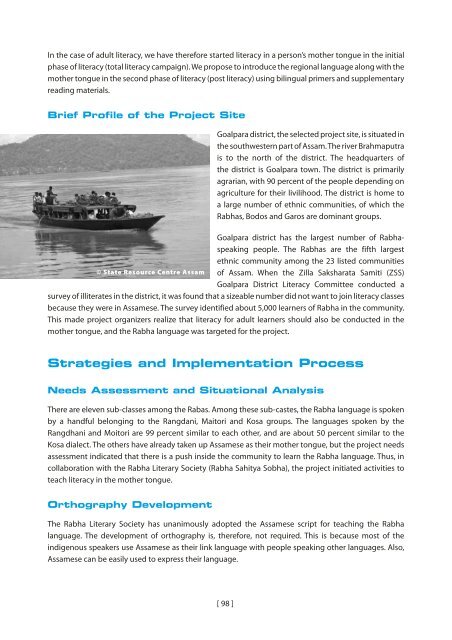Mother Tongue-based Literacy Programmes: Case Studies of Good ...
Mother Tongue-based Literacy Programmes: Case Studies of Good ...
Mother Tongue-based Literacy Programmes: Case Studies of Good ...
Create successful ePaper yourself
Turn your PDF publications into a flip-book with our unique Google optimized e-Paper software.
In the case <strong>of</strong> adult literacy, we have therefore started literacy in a person’s mother tongue in the initialphase <strong>of</strong> literacy (total literacy campaign). We propose to introduce the regional language along with themother tongue in the second phase <strong>of</strong> literacy (post literacy) using bilingual primers and supplementaryreading materials.Brief Pr<strong>of</strong>ile <strong>of</strong> the Project SiteGoalpara district, the selected project site, is situated inthe southwestern part <strong>of</strong> Assam. The river Brahmaputrais to the north <strong>of</strong> the district. The headquarters <strong>of</strong>the district is Goalpara town. The district is primarilyagrarian, with 90 percent <strong>of</strong> the people depending onagriculture for their livilihood. The district is home toa large number <strong>of</strong> ethnic communities, <strong>of</strong> which theRabhas, Bodos and Garos are dominant groups.Goalpara district has the largest number <strong>of</strong> Rabhaspeakingpeople. The Rabhas are the fifth largestethnic community among the 23 listed communities© State Resource Centre Assam <strong>of</strong> Assam. When the Zilla Saksharata Samiti (ZSS)Goalpara District <strong>Literacy</strong> Committee conducted asurvey <strong>of</strong> illiterates in the district, it was found that a sizeable number did not want to join literacy classesbecause they were in Assamese. The survey identified about 5,000 learners <strong>of</strong> Rabha in the community.This made project organizers realize that literacy for adult learners should also be conducted in themother tongue, and the Rabha language was targeted for the project.Strategies and Implementation ProcessNeeds Assessment and Situational AnalysisThere are eleven sub-classes among the Rabas. Among these sub-castes, the Rabha language is spokenby a handful belonging to the Rangdani, Maitori and Kosa groups. The languages spoken by theRangdhani and Moitori are 99 percent similar to each other, and are about 50 percent similar to theKosa dialect. The others have already taken up Assamese as their mother tongue, but the project needsassessment indicated that there is a push inside the community to learn the Rabha language. Thus, incollaboration with the Rabha Literary Society (Rabha Sahitya Sobha), the project initiated activities toteach literacy in the mother tongue.Orthography DevelopmentThe Rabha Literary Society has unanimously adopted the Assamese script for teaching the Rabhalanguage. The development <strong>of</strong> orthography is, therefore, not required. This is because most <strong>of</strong> theindigenous speakers use Assamese as their link language with people speaking other languages. Also,Assamese can be easily used to express their language.[ 98 ]

















